Palaces and Parks of Potsdam and Berlin: Potsdam was the Royal Seat of the Brandenburg-Prussian rulers. Architects and artists created an ensemble of palaces, churches, gardens and parks in Berlin and Potsdam, Germany. Some of the monuments in Potsdam: Sanssouci Park is a complex of palaces and gardens in Potsdam, built under King Frederick the Great during the 18th century. Sanssouci Palace was built for King Frederick the Great between 1745 and 1747. Sanssouci Palace is often considered the German rival to Versailles, but it is far smaller. The Neues Palais (New Palace) was built under King Frederick the Great from 1763-1769. The Neues Palais was not the principal residence of King Frederick the Great, he used the Neues Palais for the reception of important royals and dignitaries, Frederick the Great lived in his favorite palace Sanssouci. The Chinese House is a garden pavilion built in Rococo style. The Chinese House is located near Sanssouci Palace and the Neues Palais in Sanssouci Park. In 1845-1848, the Church of Peace was built in Sanssouci Park. The Church of Peace houses the imposing Mausoleum of Kaiser Friedrich III and his wife Kaiserin Victoria. The Cecilienhof was built between 1914-1917, the palace was created in the style of an English country house. The Cecilienhof was used during the Potsdam Conference in 1945. The Russian Colony Alexandrowka was built in 1826-1827 to accommodate Russian musicians. The Russian Orthodox Alexander Nevsky Church was built between 1826-1829, especially for the Russian musicians (prisoners of war). Besides the Palaces and Parks of Potsdam and Berlin, there are another two UNESCO World Heritage Sites in Berlin: the Berlin Modernism Housing Estates and the Museumsinsel (Museum Island), Berlin. The Palaces and Parks of Potsdam and Berlin were declared a UNESCO World Heritage in 1990.
www.werelderfgoedfotos.nl © Copyright World Heritage Photos Classic Car Road Trip
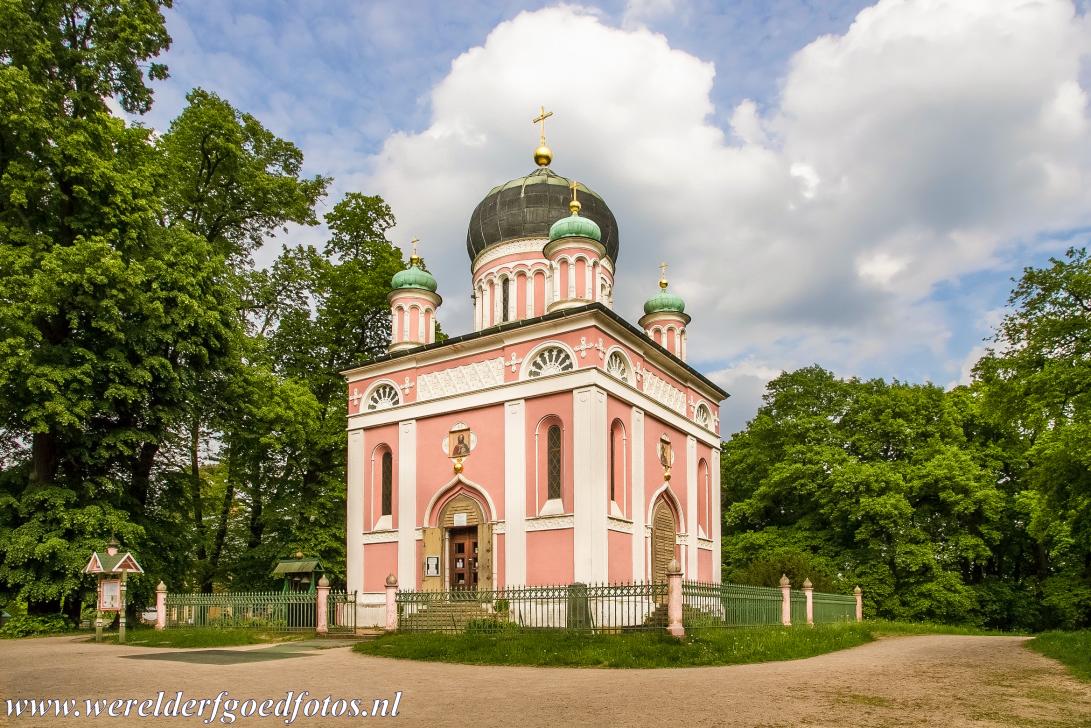
Potsdam: The Russian Orthodox Alexander Nevsky Church in the Russian Colony Alexandrowka in Potsdam. The Russian Orthodox Alexander Nevsky Church was specially built from 1826-1829 for the Russian inhabitants of Alexandrowka. The onion-shape is similar to a candle flame which was believed to be the flame of faith reaching up to heaven, it also symbolizes the prayers of the faithful drifting up to heaven. The Alexander Nevsky Church is part of UNESCO World Heritage: Palaces and Parks of Potsdam and Berlin.

Potsdam: The Russian Orthodox Alexander Nevsky Church in the Russian Colony Alexandrowka in Potsdam. The Russian Orthodox Alexander Nevsky Church was specially built from 1826-1829 for the Russian inhabitants of Alexandrowka. The onion-shape is similar to a candle flame which was believed to be the flame of faith reaching up to heaven, it also symbolizes the prayers of the faithful drifting up to heaven. The Alexander Nevsky Church is part of UNESCO World Heritage: Palaces and Parks of Potsdam and Berlin.
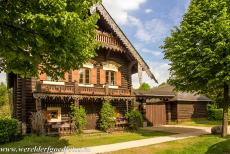
Palaces and Parks of Potsdam and Berlin: A wooden house in the Russian Colony Alexandrowka. The Russian Colony Alexandrowka was built in 1826-1827, it was the home of Russian musicians (prisoners of war) of the First Prussian Regiment of the Guards, the Russian colony was modeled after Glosova, a Russian village close to Sint Petersburg. Alexandrowka consists of the Russian Orthodox Alexander Nevsky Church and 13 wooden houses built in Russian style. Alexandrowka is situated in Potsdam, the former Royal Seat of the Brandenburg-Prussian rulers.
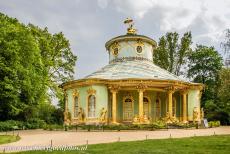
Palaces and Parks of Potsdam and Berlin: The Chinese House is a garden pavilion in Sanssouci Park, built in 1754-1757. The Chinese House is situated close to the Neues Palais and Sanssouci Palace. King Frederick the Great had the pavilion built to adorn his gardens and as a setting for small social happenings. It was the king's attempt to follow the Chinese fashion of the mid-18th century, which started in France. The Chinese House and Sanssouci Park in Potsdam are part of the UNESCO World Heritage: Palaces and Parks of Potsdam and Berlin.
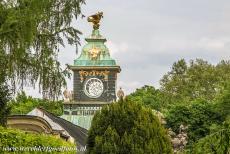
Palaces and Parks of Potsdam and Berlin: The tower of the Picture Gallery, the Bildergalerie. The Picture Gallery is situated to the east of Sanssouci Palace, it was built between 1755-1764 under the rule of King Frederick the Great, a passionate collector of paintings, the Picture Gallery is the oldest museum built for a ruler in Germany. Due to the opening of the Altes Museum, a part of the collection was transferred to Berlin in 1829. Most of the paintings were robbed by the Soviet Army during WWII, most of them returned in 1958, some of them are still in Russian hands.
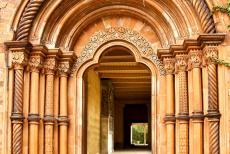
The Palaces and Parks of Potsdam and Berlin: The Heilsbronn Porch of the Friedenskirche, the Church of Peace, in Potsdam is an exact copy of a Roman porch. The Heilsbronn Porch is made of terracotta. The church was built in the period 1845-1854. An arcade surround the courtyard of the church. The church was based on Italian models. The Church of Peace is situated in the Marly Garden on the Green Fence in Park Sanssouci in Potsdam. Potsdam is situated about 25 km southwest of Berlin in Germany.
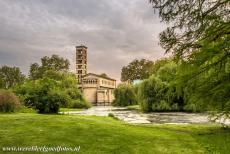
Palaces and Parks of Potsdam and Berlin: The Church of Peace in Potsdam, the Church of Peace was built in the period 1845 -1848. The free-standing bell tower has seven open floors and four bells. The bell tower of the church is 42 metres high. The design of the tower was based on the Italian Basilica di Santa Maria in Cosmedin in Rome. The Church of Peace is located in the Marly Garden in Potsdam. Potsdam was one of the residences of the Prussian Kings and the Imperial Family of Germany until 1918.
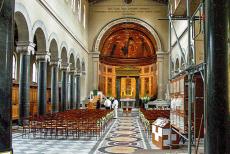
Palaces and Parks of Potsdam and Berlin: Interior of the Friedenskirche, the Church of Peace. The Church of Peace is situated in the Marly Garden, a part of Sanssouci Park in Potsdam. The church is a columned basilica and resembles an Italian monastery, it was consecrated in 1848. The 13th century Venetian mosaic above the apse came from a dilapidated church in Murano, a Venetian island. The altar canopy was made of Siberian jasper, it was a gift from Tsar Nicholas I of Russia, beneath the church lies the Royal Crypt.
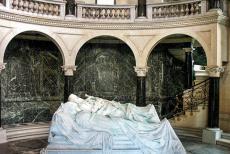
Palaces and Parks of Potsdam and Berlin: The Mausoleum of Kaiser Friedrich III and his consort Kaiserin Victoria in the Church of Peace in Potsdam. In the middle of the mausoleum stands the sculpted marble sarcophagus of Emperor Friedrich III and Empress Victoria of Germany, two of their sons who died in infancy, are also interred in this mausoleum. The 18th century Antique Temple in Sanssouci Park is also a mausoleum for members of the House of Hohenzollern, the former imperial dynasty of Germany. The small, round temple is closed to visitors.
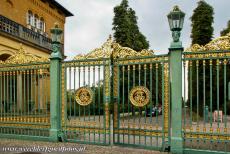
Palaces and Parks of Potsdam and Berlin: The Green Fence or the Green Gate near the Church of Peace in Sanssouci Park in Potsdam. Sanssouci Park is an ensemble of palaces and gardens, built under Frederick the Great during the 18th century. Sanssouci is the principal palace. The palace was the summer residence and favourite palace of King Frederick the Great. The Green Fence is the main entrance into Sanssouci Park. The park is embellished with fountains, follies, flowergardens and fruit gardens.
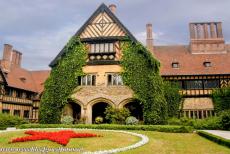
Cecilienhof Palace was built in the period 1914-1917. The Cecilienhof was created in the style of an English country house. It was the last palace built in Potsdam by the Hohenzollern dynasty. It was the residence of Crown Prince Wilhelm of Germany and his wife Cecilie. Cecilienhof Palace was used for the Potsdam Conference in 1945. The red flower star in the courtyard was created by Soviet army forces in 1945. Cecilienhof Palace is situated in the northern section of the Neuer Garten, the New Park in Potsdam.
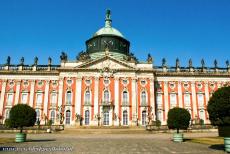
Palaces and Parks of Potsdam and Berlin: The Neues Palais was built in 1763 -1769. The Neues Palais, New Palace, is situated in Sanssouci Park in Potsdam. In the central part of the palace are four staterooms. The Rococo theatre inside the palace was built in the 18th century and is still in use today. The Grottensaal and the Marmorsaal are the most notable rooms of the palace. The huge three-winged Neues Palais was built in the Late Baroque style, the roof is decorated with a dome, the roofline is decorated with numerous statues.
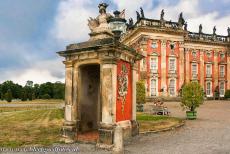
Palaces and Parks of Potsdam and Berlin: The Neues Palais, the New Palace, in Potsdam. The Neues Palais was built under King Frederick the Great from 1763-1769. For the king, the Neues Palais was not his principal residence, he used the Neues Palais for the reception of important royals and dignitaries, but Frederick the Great lived in Sanssouci Palace, his favorite palace. The Neues Palais was also the residence of Wilhelm II, the last German Emperor. The palace is part of the UNESCO World Heritage: Palaces and Parks of Potsdam and Berlin.
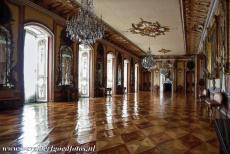
Palaces and Parks of Potsdam and Berlin: The huge ball room of the Neues Palais in Potsdam. After the abdication of Kaiser Wilhelm II in 1918, he fled to exile in the Netherlands. Furniture from the palace was taken to House Doorn, the residence of Wilhelm II in the Netherlands. The furniture he left behind in the Neues Palais was looted by the Soviet Army during World War II. The majority of the imperial furniture was discovered in the Netherlands in 1970, it was still in the packing crates, it returned to Potsdam and now the Neues Palais looks as it did in 1918.
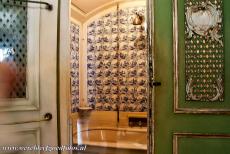
Palaces and Parks of Potsdam and Berlin: The private bathroom of Empress Augusta Victoria in the Royal apartments of the Neues Palais in Potsdam. Empress Augusta Victoria was the wife of Emperor Wilhelm II, the last emperor of Germany. The royal bath was integrated in one of the wardrobes, the walls were excessively decorated with hand painted Dutch Delft Blue tiles. After the abdication of the German emperor Wilhelm II in 1918, the Neues Palais became a museum.
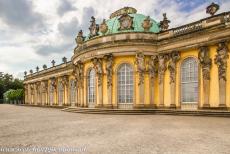
The Palaces and Parks of Potsdam and Berlin: Sanssouci Palace was built for King Frederick the Great in 1745-1747. Sanssouci Palace was the favourite palace of Frederick the Great. He died in Sanssouci Palace and was burried in the forecourt of the palace, next to his much beloved dogs. Sanssouci is often considered the German rival to the Palace of Versailles in France, but it is far smaller. Sans souci means living without a care. Sanssouci Palace is the most renowned palace of all the palaces in Potsdam and Berlin.
